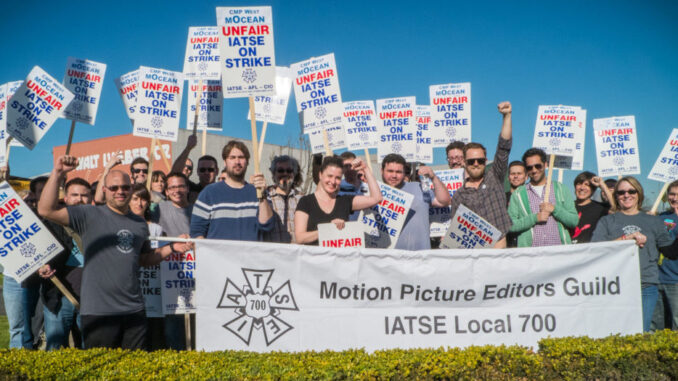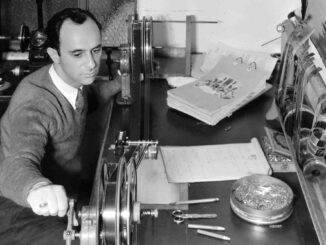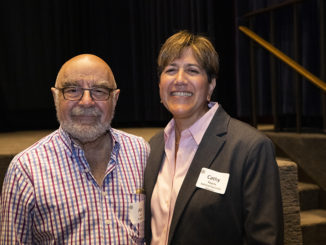
by Rob Callahan
With so many screens showing sequels, remakes, and generic plots readily reduced to loglines, it can seem as though our industry, while perhaps profligate in other respects, exercises extreme parsimony in its conservation of stories. As if out of fear of exhausting a natural resource, studios appear eager to repeatedly recycle the same few tales ad infinitum.
But if Hollywood has only a finite number of stories to tell and retell, I, as an organizer, have an even more severely limited store of narrative. In fact, I have exactly one story to tell, over and over. Fortunately, it’s a good one.
The organizer’s tale goes like this: Several individuals come to the realization that they deserve better than what those in charge want to give them; they find the courage to stand up for themselves; they develop the compassion to stand up for each other; they find power in solidarity; after a fight, they win. The story can be told with any number of different characters or settings, but the general arc of the narrative (an arc that bends, even if sometimes only at the most oblique of angles, towards justice) remains the same. The organizer’s job is to keep retelling the story, and to keep working with new casts of characters to re-enact it.
When people think of labor organizing, if they think of it at all, they generally see it in terms of winning union recognition and contracts in workplaces that were previously not unionized. In the jargon of my profession, such efforts — campaigns to organize the unorganized — are referred to as “external organizing.”
But the story doesn’t end once a formerly non-union employer is compelled to sign a contract. Unionizing a particular employer doesn’t precipitate a fade to black, with the assurance that our ensemble cast will live happily ever after. If our union is to remain strong, that initial struggle demands sequels.
The work of fostering solidarity and activism in a workplace that is already unionized is referred to as “internal organizing.” Internal organizing can take place around a grievance, a contract campaign, a violation of employees’ legal rights, or any other situation that pits the interests of management against those of employees. Internal organizing reminds employers (and our members) that the union isn’t merely some bureaucratic machine, operated by technocrats according to the arcane codes of contracts ossified in legalese. Our union is instead a living, breathing body comprised of our members and driven by their solidarity.
The Guild’s Organizing department recently helped coordinate a contract campaign that served as a good illustration of how the story of organizing repeats itself through internal organizing well after a workplace is unionized.
The post-production facility in question — a small shop in West LA that employs about three dozen members as year-round staff — had been covered under an IATSE agreement for years. Because of its union contract, the company offered a benefits package that allowed it to attract and retain talented employees. Unlike our freelancing members accustomed to going from gig to gig, many of these members had spent years in their jobs, with every expectation of more years to come. In recent years, the employer prospered and grew. Labor harmony had long prevailed, and most employees gave little thought to their union membership, except perhaps when they visited a doctor or checked in on the status of their pensions.
That all changed abruptly last autumn, when the company’s management, citing pressure from non-union competitors, announced its intention to gut the members’ union contract and to replace their Motion Picture Industry Pension and Health Plans benefits with the much less generous package offered to the company’s non-union employees. The concessions management demanded would have burdened union members with literally thousands of dollars per year in increased out-of-pocket costs, eliminated their accrual of MPI pension and retiree health benefits, slashed defined-contribution retirement benefits, and replaced contractually guaranteed terms and conditions of employment with a system that would afford management free rein to do as it pleased. The employees rightly regarded such a demand for painful concessions as an unacceptable insult. A general attitude of complacency was soon replaced by one of umbrage and, in time, insurrection.
Our members aren’t mythic heroes, but everyday people who depend on their paychecks, and for whom it took real chutzpa to stand down those who signed their checks.
Stories on the screen feature all manners of derring-do, but in reality, one of the most courageous things any of us can be called upon to do is to overtly defy the wishes of a boss. Our members did not at once erupt in open rebellion, but instead took incremental steps to demonstrate their refusal of the concessions management sought, each step a bit more defiant than the one previous.
When a politely worded letter from the employees to management was rebuffed, they all wore Local 700 lapel pins to the company’s holiday party as a gesture of solidarity. When lapel pins failed to move management, they took to more ostentatious demonstrations of resistance in the workplace, such as donning boldly-colored T-shirts emblazoned with the slogan, “Hands off our healthcare!” When, after days of T-shirts and other pro-union displays in the facility, management still refused to budge, employees took their protests to social media.
Each individual step — the wearing of shirts, the hanging of posters in the workplace, the posting of profile pictures on Facebook — was of relatively little consequence in isolation. But each trivial gesture helped underscore a message to management: The employees stood united. And each trivial gesture helped teach a lesson to the employees: They could trust one another and together they were capable of standing up to their employer.
A few days before Martin Luther King, Jr. Day, the campaign reached its climax. An attempt to resume stalled contract talks had ended acrimoniously, with management showing no signs of backing down from its insistence on eviscerating the union agreement. The employees had set MLK Day as a day of reckoning, and had let management know that the Guild needed to see a breakthrough in the stalemate before that deadline. Tensions ran high.
The Thursday before MLK Day, employees staged a one-hour work stoppage in protest of the employer’s failure to bargain in good faith. En masse, they filed out of the building, marched to the sidewalk, huddled and hefted picket signs. The actual time that our members spent on strike that Thursday afternoon was minimal; it amounted to no more than an extended lunch break. But the message was dramatic and unmistakable. Our members could act together and, together, they could halt work at the company.
I don’t want to exaggerate or aggrandize the importance of these members’ actions. Their struggle with their employer was not epic. The final showdown took place around the time of the King Holiday — a holy day indeed for those who believe in struggles for social justice — but these folks were not SNCC activists marching for the vote in Selma in 1965, nor sanitation workers on strike in Memphis in 1968. They weren’t battling oppression; they didn’t face down billy clubs or fire hoses or police dogs. These were just mostly middle-class folks with good jobs, and they were taking a stand to ensure that their jobs remained good.
But heroism happens on these small scales, too. Indeed, the grandiose sweep of history is just the aggregation and combined momentum of small gestures of defiance. As the poet Patrick Kavanagh imagines Homer asserting, “I made The Iliad from such a local row.”
Our members’ actions paid off. Within hours of their brief work stoppage, management’s lawyer was on the phone to make arrangements for a deal. Having been convinced of the employees’ resolve, and with the prospect of a more disruptive work stoppage looming, the company rushed to drop all of its onerous demands and agreed to renew the union contract on terms our members ratified unanimously and enthusiastically. Everyone will keep their health and retirement benefits. We won.
Again, the point here is that little acts matter and, repeated and magnified, they add up. Our members aren’t mythic heroes, but everyday people who depend on their paychecks, and for whom it took real chutzpa to stand down those who signed their checks. One member, openly and understandably nervous about the possible consequences of striking, explained to me her decision to push forward in spite of her fear: “There’s no greater thing in life,” she observed, “than to have the experience of fighting for something one believes in.”
She’s right: Taking a stand for what’s right, in ways large and small, is both what makes us moral beings and what makes us strong. It is a lesson of which we need to be reminded repeatedly. It is a lesson we owe to ourselves and to our co-workers to act upon each day in the workplace.





